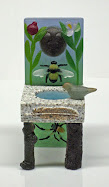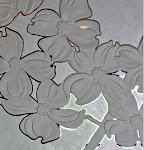Even
though Portugal is on the same latitude as New York, it enjoys a
tropical climate, rarely if ever freezing, and getting up into the 90s
during the summer and the countryside shows it with gorgeous
displays of color from bird of paradise and calla lilies and
bottlebrush and roses and all manner of flowering trees and shrubs.
During our stay the temperature ranged from a few lows in the low 50s
to some highs in the mid 70s with no humidity and clear blue days for
the most part, a few overcast and it rained off and on one day.
Driving
through the small villages house after house, courtyard after
courtyard, is filled with flowers and just about everyone has a grape
arbor as well. It was rare for me to get a picture as we passed
through as driving the narrow curvy cobblestone roads often bordered
by high walls didn't allow for stopping and picture taking.
And the Portuguese obviously love their land as it is unbelievably
clean unlike the US which is a pig sty
compared. I didn't see so much as a single scrap of paper or plastic
anywhere in my entire 3 weeks there.
this
home, in our village of Fornelo, though larger than average is still
typical in its front garden
Portuguese
homes, shops, and churches are faced with cement or stucco, painted
or plain, or beautifully patterned tile all with red tile roofs on a
hilly terrain. The main roads through the villages and towns and in
the cities as well are pavement but turn off those and you are
driving and walking on cobblestone which often, in the larger towns
and cities, had patterns and designs embedded in them.
Rural
Portugal is dotted with small clusters of houses interspersed with
small fields and vineyards which give way to more dense housing and
the village center and on Wednesday, a week into our stay, we all
piled in the car and just drove randomly around the countryside,
passing through villages, stopping now and then to take pictures or
get coffee or lunch.
the
churches all have bell towers, even in the countryside
the attached what appears to be deserted monastery. Portugal had a lot of monasteries
passing
a truck full of hay
making
random turns we picked what we thought was another narrow walled road
but it ended here
Lunch
at a local restaurant in whatever village we were in, no menu, no one
spoke English, we were sat and two platters of whatever they were
cooking were placed on the table. The place was almost empty when we
walked in but filled up quickly with people waiting for tables. The man in the foreground in the
checkered shirt and his wife approached me about sitting in two of
the four empty seats at our table and so they joined us. She leaned over
to me and asked “Frances?”. She spoke French besides Portuguese
and thought to converse. No matter, we managed a bit.


The
next day, Thursday, we returned to Oporto for a walking tour with the
Worst Tours company which consisted of two architect friends who were
trying to survive during the global economy crash of 2008 when they
came up with this idea. Our guide, Pedro, came armed with a portfolio
of maps and a wealth of knowledge of the history of Oporto and how
and why and where the city grew, asked the group of about 10 of us
what we had seen, what we wanted to see and we struck off for the
hidden environs of Oporto.
along
with the beautiful tile, there is also a lot of iron work on the
buildings...balconies, transom grates, or just ornamental
details...in traditional, art nouveau, and art deco styles
when
I paused to take this picture a workman standing on the top of the
wall behind me called out 'picture, picture' so I obliged him
Pedro,
our guide, gave us a brief history of the tile work and styles,
asking us not to buy tiles on the black market as they are usually
stolen off the buildings. Vacant spots on the upper floors, they
probably fell off, vacant spots on the ground floor, the tiles were
probably stolen.
filling
in with whatever's handy
winding
our way down to the old abandoned railway track
following
the old tracks along the river, the rails were still there but the
ties were long gone
The
tour ended at the bottom of the stairs at the edge of the tourist
waterfront where excavation and restoration of some of the old tile factories is underway.
next:
a market, a castle, and vineyards
previous:


































































